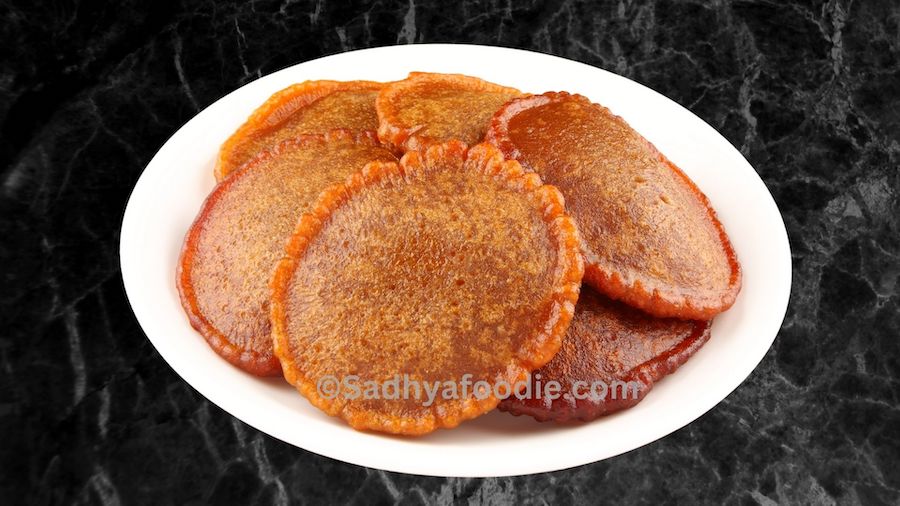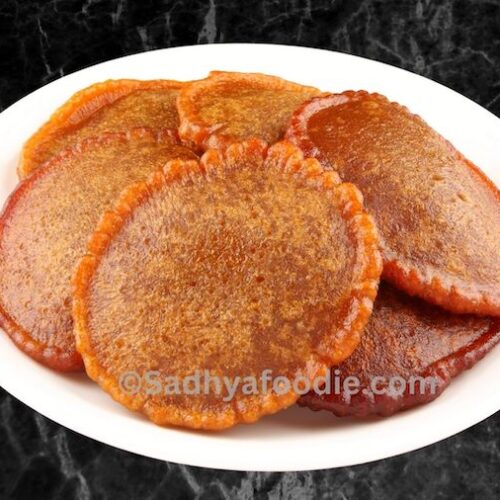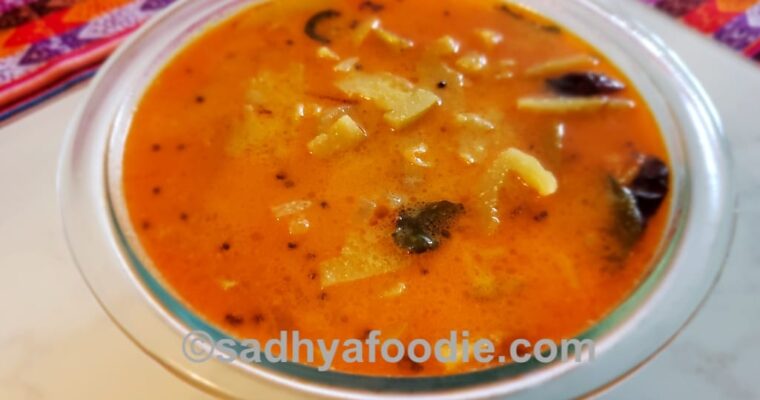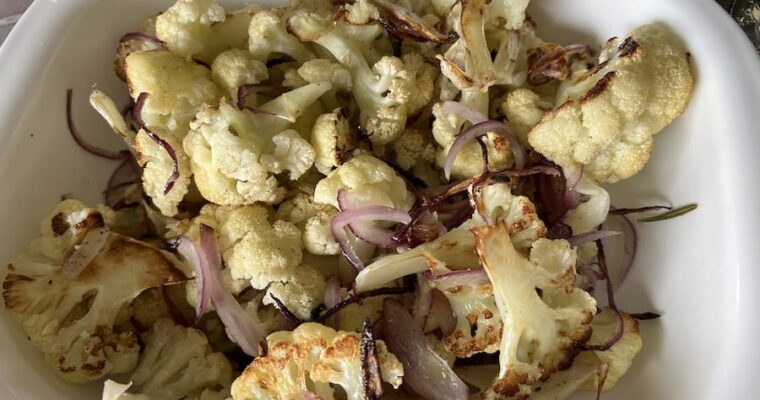Neyyappam | Naiappam

Kerala-style Neyyappam is a traditional South Indian sweet delicacy, particularly popular in the state of Kerala. It is made from a batter consisting primarily of rice, jaggery (a type of unrefined sugar), and coconut. The batter is flavored with cardamom and sometimes sesame seeds.
The preparation involves soaking raw rice, grinding it into a smooth batter along with jaggery syrup and cardamom, then fermenting it for a few hours. The batter is then fried in coconut oil until it turns golden brown and crispy on the outside while remaining soft and fluffy inside. The continuous pouring of hot oil over the Neyyappam while frying ensures even cooking and a uniform texture.
Neyyappam has a distinctive sweet flavor from the jaggery and a pleasant aroma from the cardamom. It is typically enjoyed as a snack or dessert, especially during festivals and special occasions in Kerala.
How do I know when the Neiappam is cooked properly?
The Neyyappam should turn golden brown and crisp on the outside while remaining soft and cooked inside. It’s essential to fry them on medium heat to ensure even cooking.

Nadan Neyyappam
Ingredients
- 2 cups Raw Rice
- 2 tbsp All-Purpose Flour
- 1 tbsp Ghee
- 8-10 Cardamom pods
- 1 pinch Salt
- 1-2 banana (optional)
- 2 tbsp Sesame Seeds
- 300 gram Palm Jaggery (Jaggery)
- 3/4 cup 180 ml Water
- Coconut Oil for frying
Instructions
- Soak the raw rice in water for 4 hours, then rinse and drain thoroughly.
- In a saucepan, prepare jaggery syrup by combining 300 grams of jaggery with 3/4 cup of water. Heat until the jaggery dissolves completely. Set aside to cool.
- Once cooled, grind the soaked rice along with the jaggery syrup and cardamom pods into a smooth batter. Add all-purpose flour to the batter and mix well.
- Incorporate a pinch of salt, sesame seeds, and ghee into the batter. Stir until everything is well combined.
- Allow the batter to ferment for about 14 hours, covered, in a warm place.
- Mash the banana and add this to the batter. Mix all together very well.
- Heat coconut oil in a deep frying pan. Once the oil is hot, reduce the flame to medium.
- Pour the batter into the oil from the middle in small batches. As the batter begins to rise to the top, reduce the flame to low.
- Continuously pour hot oil over the top of the Neyyappam to ensure even cooking.
- Fry until the Neyyappam turns golden brown and crisp on all sides.
- Remove from the oil and drain excess oil on paper towels.
- Serve warm and enjoy the delicious Kerala style Neyyappam!
Neyyappam is a traditional dish popular in South India, particularly in Kerala. Different regions within Kerala and other South Indian states may have their unique variations of Neyyappam, influenced by local ingredients, culinary traditions, and family recipes. As you can see below there are many variations!
People may have their own preferences when it comes to Neyyappam, leading to variations in ingredients, proportions, or cooking techniques. Some may prefer a sweeter version with more jaggery, while others may prefer a less sweet or spicier variation.
Neyyappam Recipe without all-purpose flour
Neyyappam is a traditional South Indian delicacy, and rice flour is the primary ingredient in many South Indian sweets and snacks. By using rice flour exclusively, you’re staying true to the original recipe and preserving its authenticity.
Ingredients:
- 1/2 kg Palm Jaggery (Karuppatti)
- 3/4 cup Water
- 6 cups Rice Flour
- 4-5 tbsp Coconut Slices (dry or fresh)
- 2 tbsp Ghee
- 3/4 tsp Cardamom Powder
- 2 tbsp Black Sesame Seeds
- Coconut Oil for deep frying
Instructions:
- In a saucepan, melt the palm jaggery with 3/4 cup of water. Once melted, strain the jaggery syrup to remove any impurities. Allow it to cool down to room temperature.
- If using dry coconut, heat 2 tbsp of ghee in a pan. Add coconut slices and fry them until they turn golden brown. Set aside.
- In a large mixing bowl, take the rice flour. Gradually pour the cooled jaggery syrup into the flour, stirring continuously to make a thick batter. Ensure there are no lumps.
- Add the fried coconut slices, cardamom powder, and black sesame seeds to the batter. Mix well to incorporate all ingredients evenly.
- Allow the batter to ferment for about 2 hours in a warm place.
- Heat coconut oil in a deep frying pan over medium heat. When the oil is hot, reduce the heat to medium.
- Take a spoonful of the batter and pour it into the hot oil. The batter will rise up as it cooks. Fry until both sides turn golden brown, ensuring even cooking.
- Remove the Neyyappam from the oil and drain excess oil on paper towels.
- Repeat the frying process with the remaining batter.
- Serve the Neyyappam warm and enjoy its delicious flavor!
Note: Maintain medium heat while frying to ensure the Neyyappam cooks evenly throughout. Adjust the thickness of the batter as needed by adding more jaggery syrup or rice flour.
Kerala Style Neyyappam – Variation
Ingredients
- 1 cup (230 grams) Rice
- 175 grams Jaggery (crushed into small pieces)
- 3 tablespoons All-Purpose Flour
- 4-5 Cardamom Pods
- 1 teaspoon Cumin Seeds
- 1 tablespoon Sesame Seeds
- 1 tablespoon Ghee
- 1 pinch Salt
- Oil for deep frying
Instructions:
- Wash and Soak the rice in water for 4-5 hours. Then drain the rice thoroughly.
- In a saucepan, melt the jaggery with 1/2 cup of water. Once melted, strain the mixture to remove any impurities. Set aside and allow it to cool down.
- Grind the soaked rice with the jaggery syrup until you achieve a coarse consistency. Avoid grinding it into a fine paste.
- Add the all-purpose flour and a little more jaggery syrup to the blender. Mix lightly, then transfer to a bowl.
- To the bowl, add sesame seeds, cumin seeds, ghee, ground cardamom, and a pinch of salt. Mix well and set aside for 8 hours.
- After 8 hours, stir the batter again and check the consistency. Adjust as needed by adding more jaggery syrup if too thick or rice flour if too thin.
- Heat oil in a pan for deep frying. Once the oil is hot, pour a ladleful of batter into the oil. The batter should rise up in about 10-12 seconds if the temperature is correct. Reduce the temperature to medium low and cook.
- Once the top part of the Neyyappam has bubbled up, pour some hot oil over the top. Then, turn it over and cook until both sides are golden brown.
- Continue frying the Neyyappam in batches, stirring the batter each time before pouring into the oil.
- Drain the fried Neyyappam on paper towels to remove excess oil.
- Serve warm and enjoy this delicious South Indian treat!
Note: Be cautious while frying Neyyappam to ensure they are cooked evenly and reach a golden brown color on both sides. Adjust the heat as needed to maintain the correct frying temperature.
Kerala Style Neyyappam with Banana
Neyyappam recipes are often passed down through generations within families. Each family may have its own recipe, which may vary slightly from other versions due to personal touches or adaptations over time. Banana often added in Neyyappam recipe.
Ingredients:
- 1 cup Raw Rice
- 1/4 cup All-Purpose Flour
- 175 gram Crushed Jaggery
- 1 Banana
- 1/2 tsp Cardamom Powder
- 1 tsp Dry Ginger Powder
- 1 tsp Black Sesame Seeds
- 2 tbsp Thinly Sliced Coconut
- 2 tbsp Ghee
- Salt to taste
- Cooking Oil for deep frying
Instructions:
- Wash the raw rice and soak it in water for 4-5 hours.
- Crush the jaggery and make a syrup by boiling it with 1/2 cup of water. Strain the syrup to remove any impurities and let it cool down.
- Heat 1 tablespoon of ghee in a pan. Add thinly sliced coconut and fry until it turns golden brown. Set aside.
- Drain the soaked rice and add it to a blender. Grind the rice by gradually adding the jaggery syrup, little at a time. Do not add any additional water. Transfer the ground mixture to a large bowl.
- Peel the banana and grind it into a fine paste using a blender.
- In a large mixing bowl, combine the rice mixture, all-purpose flour, mashed banana, dry ginger powder, cardamom powder, black sesame seeds, fried coconut, remaining ghee, and salt to make a semi-thick batter.
- Set aside the batter for 4-5 hours to ferment.
- Heat cooking oil in a deep-bottomed pan for deep frying. When the oil is hot, reduce the heat to medium.
- Pour a ladleful of batter into the hot oil. Fry the Neyyappam until they turn golden brown and crispy on both sides.
- Remove the fried Neyyappam from the oil and drain excess oil on paper towels.
- Repeat the frying process with the remaining batter, stirring it well each time before pouring into the oil.
- Serve the Neyyappam warm and enjoy!
Note:
- Do not use roasted rice flour.
- Optionally, you can add 1/4 tsp of baking soda to the batter for added fluffiness.
Several factors contribute to making a good Neyyappam:
- Consistency of Batter: The batter should be thick and smooth, with the right balance of rice flour and jaggery syrup. It shouldn’t be too runny or too thick.
- Quality of Ingredients: Using high-quality ingredients, such as good quality rice flour, fresh palm jaggery, and flavorful coconut slices, enhances the taste and texture of Neyyappam.
- Flavor Profile: Neyyappam gets its distinct flavor from ingredients like palm jaggery, coconut slices, cardamom powder, and black sesame seeds. The balance of these flavors is crucial for a delicious outcome.
- Frying Technique: Frying the Neyyappam at the right temperature is essential. The oil should be hot enough to ensure even cooking and a crispy exterior while preventing it from being greasy.
- Even Cooking: Ensuring that the Neyyappam cooks evenly on both sides is vital. This can be achieved by flipping them at the right time during frying and maintaining a consistent heat level.
- Fermentation: Allowing the batter to ferment for a few hours helps develop flavor and texture. Fermentation also aids in making the Neyyappam light and fluffy.
FAQs
It’s traditional to use palm jaggery (Karuppatti) for Neyyappam. However, if palm jaggery is unavailable, you can use regular jaggery made from sugarcane.
Start by adding jaggery syrup to the rice flour gradually until you achieve a thick batter consistency. The batter should coat the back of a spoon but still have a pouring consistency.
While coconut slices and sesame seeds contribute to the authentic flavor and texture of Neyyappam, you can omit them if necessary. However, they do enhance the overall taste.
Fermentation helps to develop flavor, improve texture, and make the Neyyappam light and fluffy.
Coconut oil is traditionally used for frying Neyyappam as it imparts a unique flavor. However, you can use any neutral-flavored oil if coconut oil is unavailable.
Allow the Neyyappam to cool completely before storing them in an airtight container. They can be stored at room temperature for up to 2-3 days. Reheat them in an oven or microwave before serving.

![Authentic Kerala Beans Mezhukkupuratti: Beans Stir Fry [VIDEO]](https://sadhyafoodie.com/wp-content/uploads/2025/03/beans-mezhukkuvarati-760x400.jpg)


